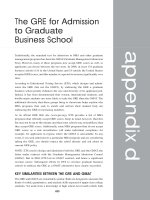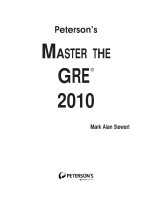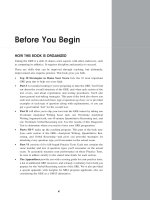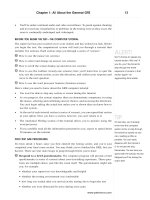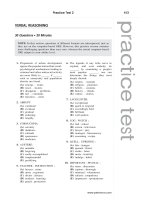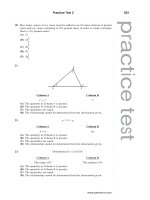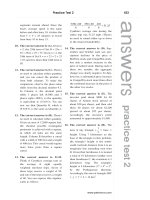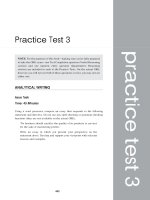Tài liệu Master the Gre 2010 - Part 44 pdf
Bạn đang xem bản rút gọn của tài liệu. Xem và tải ngay bản đầy đủ của tài liệu tại đây (92.45 KB, 10 trang )
VERBAL REASONING
30 Questions • 30 Minutes
NOTE: In this section, questions of different formats are interspersed, just as
they are on the computer-based GRE. However, this practice session contains
more challenging questions than easy ones, whereas the actual computer-based
GRE adapts to your ability level.
1. Proponents of urban development
oppose the popular notion that social-
psychological mechanisms leading to
criminal and other antisocial activity
are more likely to _______ if _______
such as anonymity and population
density are found.
(A) emerge . . traits
(B) react..factors
(C) disappear . . problems
(D) fail . . criminals
(E) function..cities
2. ABRUPT:
(A) continual
(B) eventual
(C) gradual
(D) enduring
(E) lengthy
3. CORNUCOPIA:
(A) serenity
(B) darkness
(C) solitude
(D) sparseness
(E) modicum
4. AUSTERE:
(A) amiable
(B) forgiving
(C) easily accomplished
(D) simpleminded
(E) gratifying
5. TEACHER : INSTRUCTION ::
(A) lawyer : crime
(B) army : regiment
(C) doctor : disease
(D) student : learning
(E) guard : protection
6. The legends of any tribe serve to
explain, and even embody, its
_______; by examining a people’s
most popular _______, one can
determine the things they most
deeply cherish.
(A) origins..legends
(B) religion . . pastimes
(C) beliefs . . customs
(D) history..rituals
(E) values..stories
7. LACKLUSTER:
(A) exceptional
(B) quick to respond
(C) exceedingly bold
(D) brilliant
(E) well spoken
8. COG : WATCH ::
(A) fish : school
(B) screen : television
(C) lawyer : jury
(D) manager : bureaucracy
(E) seasoning : recipe
9. QUELL : UPRISING ::
(A) bite : hunger
(B) quench : thirst
(C) strike : labor
(D) incite : hostility
(E) indulge : habit
10. IMPORTANT : PIVOTAL ::
(A) stern : draconian
(B) copious : thorough
(C) minimal : voluminous
(D) salient : compulsory
(E) impetuous : spontaneous
practicetest
Practice Test 2 413
.................................................................
..............................................................................................
www.petersons.com
Questions 11 and 12 are based on
the following passage.
For absolute dating of archaeological
artifacts, the radiocarbon method
emerged during the latter half of the
twentieth century as the most reliable
and precise method. The results of
obsidian (volcanic glass) dating, a
method based on the belief that newly
exposed obsidian surfaces absorb
moisture from the surrounding atmo-
sphere at a constant rate, proved
uneven. It was initially thought that
the thickness of the hydration layer
would provide a means of calculating
the time elapsed since the fresh
surface was made. But this method
failed to account for the chemical vari-
ability in the physical and chemical
mechanism of obsidian hydration.
Moreover, each geographic source pre-
sented unique chemical character-
istics, necessitating a trace element
analysis for each such source.
Yet despite its limitations, obsidian
dating helped archaeologists identify
the sources of many obsidian artifacts,
and to identify in turn ancient
exchange networks for the flow of
goods. Nor were ceramic studies and
fluoride analysis supplanted entirely
by the radiocarbon method, which in
use allows for field labeling and labo-
ratory errors, as well as sample con-
tamination. In addition, in the 1970s,
dendrochronological (tree-ring) studies
on the bristlecone pine showed that de-
viation from radiocarbon values in-
creases as one moves back in time. Even-
tually calibration curves were developed
to account for this phenomenon; but in
the archeological literature we still find
dual references to radiocarbon and si-
dereal, or calendar, time.
11. The author would probably consider
which of the following the LEAST
likely means of dating archaeological
artifacts?
(A) Ceramics studies
(B) Radiocarbon dating
(C) Dendrochronological studies
(D) Fluoride analysis
(E) Obsidian hydration-layer
analysis
12. The author mentions all of the fol-
lowing as problems with radiocarbon
dating EXCEPT for
(A) disparities with the calendar
dating system
(B) deterioration of samples
(C) identification errors by archaeo-
logical field workers
(D) contamination of artifacts
(E) mistakes by laboratory workers
13. RANCOR:
(A) tranquility
(B) happiness
(C) impartiality
(D) humor
(E) affection
14. The recent birth of septuplets has
spawned many newspaper articles
presenting _______ accounts of
medical problems associated with
multiple births, _______ the initial
heartwarming stories about the sep-
tuplets that dominated the press.
(A) depressing..minimizing
(B) various . . contradicting
(C) dispassionate . . obscuring
(D) sobering . . counterbalancing
(E) detailed . . substantiating
PART VI: Five Practice Tests414
.................................................................
..............................................................................................
www.petersons.com
Questions 15–18 are based on the
following passage.
The Andean cordillera is made up of
many interwoven mountain ranges, which
include high intermontane plateaus,
basins, and valleys. The Northern Andes
region contains several broad ecosystems
that fall into four altitudinal belts. Its
northern subregion is distinguished by
high humidity and by greater climatic
symmetry between eastern and western
flanks. The Central Andes is characterized
by a succession of agricultural zones with
varied climatic conditions along the
region’s mountain flanks and by large,
high-altitude plateaus—variously called
puna or altiplano—which do not occur in
the Northern Andes. The soil fertility of
the northern altiplano is generally good,
whereas the western Central Andean
ranges are relatively arid with desert-like
soils. The eastern ranges are more humid,
like the Northern Andes, and have more
diverse soils.
Broadly speaking, the weather patterns
of the Andean cordillera reflect the move-
ments of high- and low-pressure cells
associated with the Intertropical Conver-
gence Zone, a low-pressure trough that
moves north and south on a seasonal
basis. These cells have their greatest
impact in the Central Andes, where
highland precipitation is seasonal. With
increasing distance south of the equator,
the seasonality of precipitation in the
Central Andes increases, whereas the
total annual amount generally decreases.
The aridity of the Central Andes coastal
zone is the result of the drying effect of the
cold Pacific Humboldt current and the
southern Pacific high-pressure cell.
In contrast to regions of gentle topog-
raphy, where climatic variation can be
determined from a few widely spaced mea-
surements, climatic projections in the
Andean cordillera are quite difficult. For
example, while air temperature generally
decreases with increasing altitude, vari-
ability of mountain topography can
produce much lower than expected air
temperatures. Nevertheless, some general
climatic patterns are discernible.
Humidity commonly increases with
increasing altitude, but only to some inter-
mediate altitude, above which it declines.
The variability of mountain terrain also
affects precipitation, such that conditions
of extreme wetness and aridity may exist
in close proximity. Related to this tem-
perature gradient is a pattern of greater
rainfall at the valley heads and less rain
at lower altitudes—particularly in the
Central Andes—resulting in part from a
mountain rainshadow effect.
15. The passage is primarily concerned
with
(A) describing the geologic features
of various regions of the
Andean cordillera
(B) discussing the factors affecting
the climate of the Andean
cordillera
(C) providing alternative explana-
tions for the climatic diversity
among different regions of the
Andean cordillera
(D) examining the effects of
topography on the precipitation
throughout the Andean cor-
dillera
(E) comparing the climate of the
Northern Andes to that of the
Central Andes
16. According to the passage, the north-
ern part of the high-altitude pla-
teaus is characterized by which of
the following?
(A) Fertile soil
(B) High relative humidity
(C) A succession of agricultural
zones
(D) Extremes in air temperature
(E) An arid climate
practicetest
Practice Test 2 415
.................................................................
..............................................................................................
www.petersons.com
17. It can be inferred from the passage
that air temperatures in the Andean
cordillera are often “lower than
expected” probably due to wide
variations in
(A) precipitation levels
(B) air pressure
(C) prevailing wind direction
(D) aridity
(E) mountain elevation
18. The passage mentions all the fol-
lowing as climatic factors in the
Central Andes cordillera EXCEPT
for
(A) the Intertropical Convergence
Zone
(B) the rainshadow effect
(C) the southern Pacific high-
pressure cell
(D) the symmetry of the mountain
ranges
(E) the Pacific Humboldt current
19. WAN:
(A) flushed
(B) robust
(C) patchy
(D) twinkling
(E) comely
20. SCULPTURE : SHAVING ::
(A) analysis : insight
(B) burglary : arrest
(C) experiment : hypothesis
(D) therapy : comfort
(E) education : opportunity
21. Mark Twain and Garrison Keillor
were both born and bred in Mid-
western America; yet the themes,
writing styles, and attitudes of these
two humorists are _______.
(A) widely admired
(B) essentially timeless
(C) distinctly different
(D) quite remarkable
(E) nearly identical
22. PRIZE : LOTTERY ::
(A) grade : student
(B) loan : bank
(C) game : casino
(D) diploma : college
(E) rank : tournament
23. CIRCUMSPECT : VIGILANCE ::
(A) courageous : bravado
(B) amicable : belligerence
(C) ardent : enthusiasm
(D) miserly : wealth
(E) intransigent : stability
24. In certain instances, tradition must
yield entirely to the utilitarian needs
of modern life. When it comes to his-
toric public buildings, whose struc-
tural integrity is (i)_______ to the
safety of the general public, modern-
ization sometimes requires no
less than razing the structure and
building anew. In other such
cases, however, architecturally
appropriate retrofits can solve struc-
tural problems without sacrificing
(ii)_______, while alternative loca-
tions can be used for new buildings
as needed.
Blank (i)
paramount
integral
imperative
Blank (ii)
history or tradition
aesthetic cohesiveness
utilitarian needs
Questions 25 and 26 are based on
the following passage.
The heart of the restorationist critique
of environmental preservationism is the
claim that it rests on an unhealthy
dualism that conceives nature and
humankind as radically distinct and
opposed to each other. The crucial
question about the restorationist outlook
has to do with the degree to which the
restorationist program is itself faithful to
its first principle—that nature and
humanity are fundamentally united
rather than separate.
Rejecting the old domination model,
which sees humans as over nature, resto-
ration theory champions a model of com-
munity participation. Yet some of the
descriptions of what restorationists are
actually up to—for example, Turner’s
PART VI: Five Practice Tests416
.................................................................
..............................................................................................
www.petersons.com
description of humans as “the lords of cre-
ation,” or Jordan’s statement that “the
fate and well being of the biosphere
depend ultimately on us and our rela-
tionship with it”—do not cohere well with
the community-participation model.
Another holistic model—namely, that of
nature as an organism—might be more
serviceable to the restorationists. As with
the community model, the “organic” model
pictures nature as a system of intercon-
nected parts. A fundamental difference,
however, is that in an organism the parts
are wholly subservient to the life of the
organism.
25. In asserting that the organic model
“might be more serviceable to the
restorationists,” the author implies
that
(A) the descriptions by Turner and
Jordan of the restorationists’
program conform more closely
to the organic model than to
the community participation
model
(B) the organic model is more
consistent than the community
participation model with the
principle of restoration
(C) the organic model is more
consistent with the restora-
tionists’ agenda than with the
preservationists’ program
(D) holistic models are more useful
than the dualist model to the
restorationists
(E) the organic model, unlike the
community participation model,
represents nature as a system
of interconnected parts
26. Which of the following best expresses
the function of the first paragraph in
relation to the second one?
(A) To establish the parameters of
an ensuing debate
(B) To discuss a secondary issue as
a prelude to a more detailed
examination of a primary issue
(C) To provide an historical
backdrop for a discussion of a
modern-day issue
(D) To introduce opposing view-
points, which are then
evaluated
(E) To identify a problem with a
school of thought, which is then
explored in detail
27. The science of astronomy is widely
viewed today as _______ at least as
much as theoretical, in that sooner
or later what astronomers detect
finds its way into theory, or the
theory is modified to _______ it.
(A) observational..disprove
(B) beneficial . . accept
(C) empirical . . embrace
(D) practical . . demonstrate
(E) important . . supersede
28. QUARRY : MARBLE ::
(A) well : oil
(B) ocean : tuna
(C) silo : grain
(D) reservoir : water
(E) observatory : stars
29. SNORKEL : DIVE ::
(A) baton : run
(B) taps : dance
(C) blade : skate
(D) ball : kick
(E) club : golf
30. EXACERBATE:
(A) prevent from occurring
(B) lessen in degree
(C) withhold praise
(D) smooth over
(E) treat condescendingly
practicetest
Practice Test 2 417
.................................................................
..............................................................................................
www.petersons.com
